Review of Mondly VR Language Learning for Oculus 2
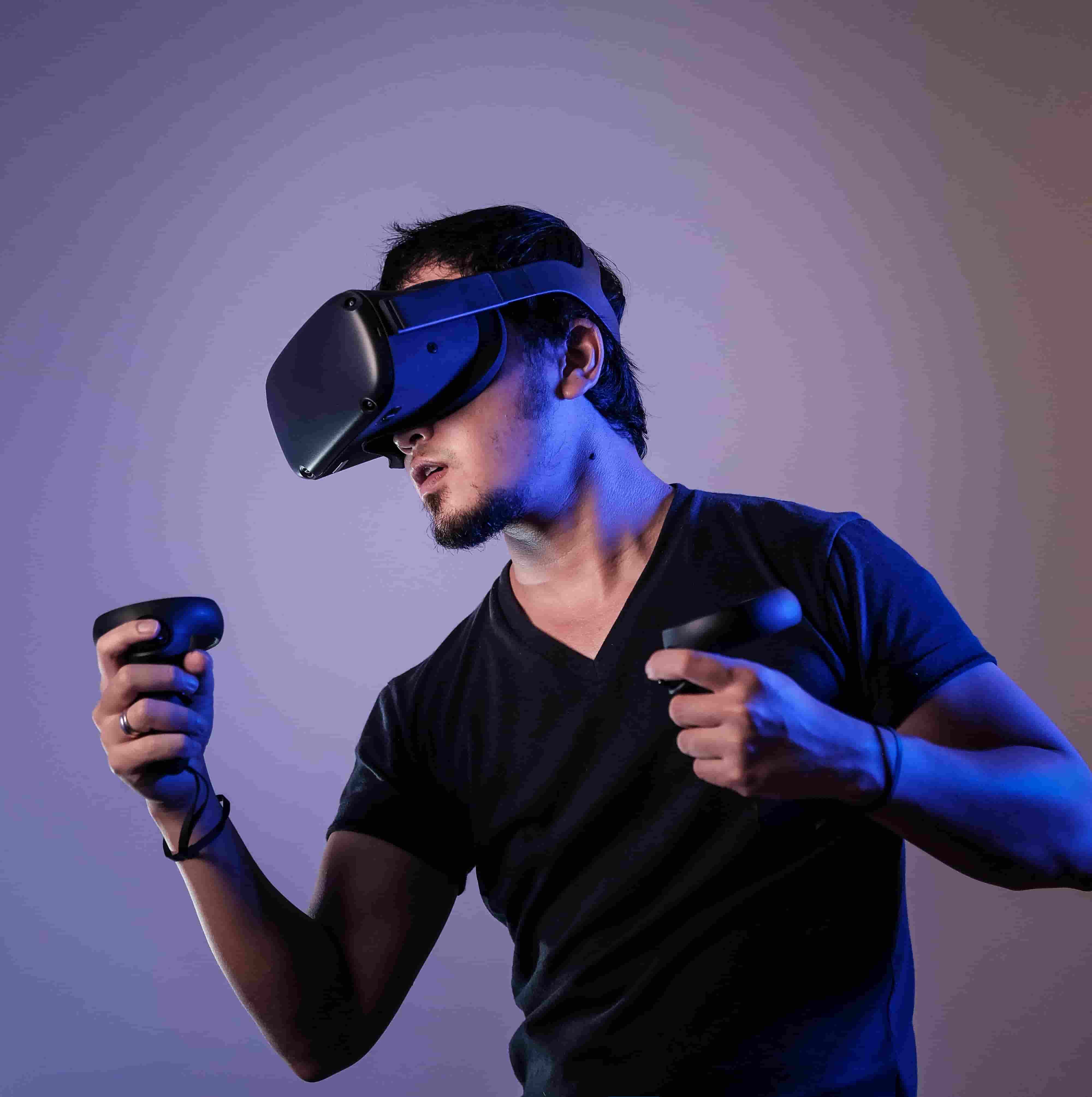
By Edwige Simon, PhD, Instructional Technology and Online Learning Director at ICLS
Mondly VR Language Learning was first released in 2017 and became available on Oculus 2 in August 2021. The app costs $10 and offers immersive training in 29 languages.
Upon launching the app, the program prompts you to choose your native and target language from a list of 30 languages. You then have the choice between vocabulary and conversation practice.
Vocabulary Practice
There are five vocabulary lessons on the following themes: Intro (6 animals), Space, Fruit, Animals, Vegetables (1), and Vegetable (2).
There are about six words introduced in each lesson. The vocabulary lessons are situated, for example, you learn about the fruit and the vegetables inside a supermarket and about animals in what looks like a zoo. The avatar introduces each word, tells you how to pronounce it, and shows you an image (see Screenshot 1). The word also appears in writing on the screen. The avatar asks you to practice pronouncing some of the words and relies on Automatic Speech Recognition (ASR) for feedback. If pronounced correctly, the lesson continues; if not, the avatar asks you to try again. The lesson concludes with a brief review of some of the words presented in the lesson.
Screenshot 1: You practice each word by hearing how it is pronounced and repeating it.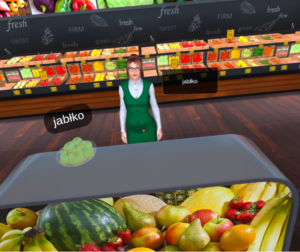
Review of Vocabulary Practice
Overall, the vocabulary lessons offer an immersive way to practice new words and become acquainted with the sounds of a new language. The words are presented in a logical location (you learn the space vocabulary outside a space station for example) which helps with retention and contributes to the fun factor.
That said, you will learn or review less than 40 words across the six lessons, and some of these words are relatively low frequency (solar system, telescope, crocodile) and, as a result, are not very useful to learners. The words themselves are not contextualized, except for when the avatar occasionally inserts them in a sentence.
Throughout the lesson, the avatar intersperses fun facts and jokes about the vocabulary words in English, which feels irrelevant and, at times, distracting.
Finally, the vocabulary lessons are disconnected from the conversation. It would have made sense to align the vocabulary words with the situations in which the conversations occur (taking a cab, ordering food, etc.).
Conversation Practice
Upon choosing to practice your conversation skills in the target language, you get to choose from 3 levels (beginner, intermediate or advanced). You then find yourself in a cozy living room in front of a handwritten letter. The author of the letter informs you that it’s been too long since you’ve seen each other. A short movie sequence ensues where you pack your suitcase, head to the airport, board a plane, and land at your destination.
There are eight situations that you may complete out of order if you wish:
- Hello (meeting a person on a train)
- Taking a taxi
- Getting a hotel room (conversation with the receptionist)
- Asking for a different room
- Restaurant (ordering food, chatting with a stranger)
- Shopping for clothes
- Making an appointment
- Buying a train ticket
Each situation starts with a person greeting you, and you have to answer back, thus engaging in a mini dialogue. Here is a short video clip showing part of an exchange. To input your answer, you click a microphone icon to activate Automatic Speech Recognition (see Screenshot 2). The number of acceptable answers is generally limited to three options. Once you have completed a situation, you receive a star rating out of three, reflecting how well you did on the dialogue, according to ASR.
The situations are the same at all three levels but the level of scaffolding provided by the program varies:
- Beginner: the dialogue lines appear by default on the screen; you can choose your cues from a selection of three options.
- Intermediate (see screenshot 2): you can make the dialogues appear on screen if you need them.
- Advanced: no dialogues on screen, but you can slow down the avatar’s speech and skip ahead if you don’t know what to say.
Screenshot 2: At the intermediate level, the dialogues do not appear on screen by default, but if you don’t understand what the avatar (here a waitress) said to you, you can make her lines appear on the screen. You can also make the English translation appear if you need it.
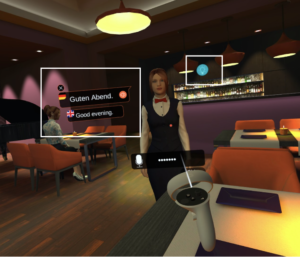
Screenshot 3: At the intermediate level, if you do not know what to say to the avatar who just greeted you, you can make several choices appear on the screen and choose one answer to record. The program uses ASR to evaluate your pronunciation.
Review of Conversation Practice
The situations feel immersive at times, especially at the very beginning when you find yourself on an airplane. The ambiance noises are a nice touch (there is a pianist in the hotel restaurant). The headset effectively conveys a sense of movement when riding an escalator or a cab, which contributes to the feeling of being there.
Each situation is short and provides an enjoyable language experience that makes you curious about what the following situation will bring.
From a language learning standpoint however, this app will deliver limited outcomes.
The content covered is the same at all three levels, so there is no progression from beginner to advanced. Since there are eight situations, and each situation takes around 5 minutes to complete, you will complete the beginner or any other level in about an hour.
The situations prompt you to exchange around 10 to 15 lines of dialogue, many of which are “Hi,” “Thank you,” or Goodbye.” While the program appears to follow a task-based approach, much of your success in the app depends on your ability to memorize the dialogues in each situation, which you inevitably start doing since the program can’t handle anything outside of the scripts they created.
Finally, while the program feels immersive at times, the avatars and graphics are relatively low quality, especially compared to the quality of graphics found in commercial games.
The Future of VR and Language Learning
Mondly is a first step in the right direction and a compelling proof of concept, but as it stands, it is not an actual vehicle for language acquisition. For a VR app to deliver a productive language learning experience would require a few additional elements:
- Allowing users to interact with the environment: the experience would be richer if the learners could walk around, move objects, or read letters, emails or menus to collect information. This type of interaction is already an integral part of VR games such as The Room, A Dark Matter.
- Immersing the learner in the target culture: The true potential of VR lies in its ability to transport the user to the target country. The experience would be a lot more immersive if the user found themselves in the streets of Tokyo or a Parisian restaurant.
- Finally, an effective language learning program would need to rely on accurate ASR and powerful Natural Language Processing (NLP) to allow the avatars to handle some levels of variation and complication beyond three built-in options.
The addition of these elements would prompt the negotiation of meaning essential to language learning.
Conclusion
If you already own the Oculus headset and are interested in language learning, for $10, Mondly is a fun experience that I would highly recommend. VR has tremendous potential for language learning, but it yet has to leverage what we know about language learning and the conditions in which it can take place successfully. Other VR language learning tools such as ImmerseMe are heading in that direction.
VR Language Learning experiences such as Mondly or ImmerseMe aim at recreating a semi-authentic live interaction with an avatar. However, VR also holds much potential for facilitating interactions between learners in an immersive environment. In other words, rather than interacting with an avatar, learners can currently interact with other learners, teachers, and native speakers in immersive situations that simulate situations they are likely to encounter in the target country. Apps such as AltSpace VR or VRchat offer spaces for these types of interaction.
Learn more about using teacher tools online (including ChatGPT for language teachers) at our Teacher PD tech workshops.
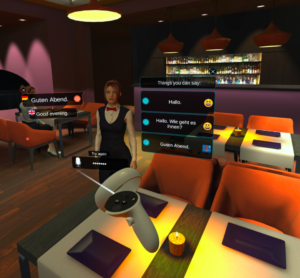
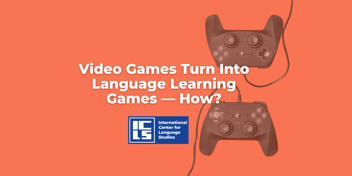
.png?width=352&name=Plateau%20(1).png)
